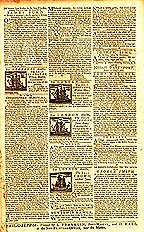 |
Colonial Leader
![]()
Benjamin
Franklin first became acquainted with the operation of Iroquois political
organization in his position as official printer for the colony of Pennsylvania.
His job included publication of the records and speeches of the various Indian
assemblies and treaty negotiations.
Because of his expertise and experience with the Iroquois, the colonial government of Pennsylvania offered him his first diplomatic assignment as their Indian commissioner. He held this post during the period of the Albany Congress and became intimately familiar with the political organization of the Iroquois Confederacy.
Bruce E. Johansen has written extensively about the influence of the Iroquois Confederacy on the founding fathers. This passage is from his book Forgotten Founders.
![]()
| "Franklin could not help but admire the proud, simple life of America's native inhabitants. There was a noble quality in the stories...which he told of their hospitality and tolerance, of their oratory and pride." Franklin saw in Indians' conduct "a living symbol of simplicity and 'happy mediocrity,' exemplifying essential aspects of the Virtuous Order." Depiction of this "healthful, primitive morality could be instructive for transplanted Englishmen, still doting on 'foreign Geegaws.' Happiness, Franklin wrote, 'is more generally and equally diffused among savages than in our civilized societies." "Happy mediocrity" meant striking a compromise between the overcivilization of Europe, with its distinctions between rich and poor and consequent corruption, and the egalitarian, democratic societies of the Indians that formed a counterpoint to European monarchy. The Virtuous Order would combine both, borrowing from Europe arts, sciences, and mechanical skills, taking from the Indians aspects of the natural society that Franklin and others believed to be a window on the pasts of other cultures, including those from which the colonists had come. There is in the writings of Franklin, as well as those of Jefferson, a sense of using the Indian example to recapture natural rights that Europeans had lost under monarchy. ... Franklin (as well as Jefferson) sought to erect an amalgam, a combination of indigenous American Indian practices and the cultural heritage that the new Americans had carried from Europe. In discussing the new culture, Franklin and others drew from experience with Native Americans, which was more extensive than that of the European Natural Rights Philosophers. The American Indians' theory and practice affected Franklin's observations on the need for appreciation of diverse cultures and religions, public opinion as the basis for a polity, the nature of liberty and happiness, and the social role of property. American Indians appear frequently in some of Franklin's scientific writings" (Johansen 83-84) |
To learn what Franklin had to say about the Albany Congress, read chapter 12 of Benjamin Franklin's autobiography. Read the full text of the Albany Plan of Union to learn about the plan for one general government in America.
![]()
Learning Aids | Great Law of Peace | US Constitution | Timeline | Works Cited
© 1 October 2001, Portland State University